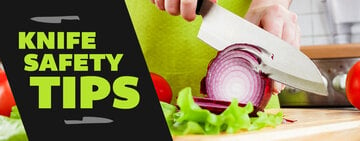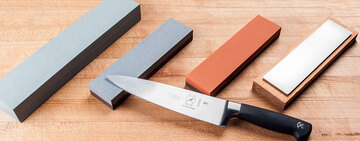
Cutting board safety is fundamental to preventing cross-contamination and maintaining sanitation in any commercial kitchen. Despite its essential role, widespread misconceptions about material selection, maintenance, and proper use persist, creating unnecessary risk. This FAQ provides answers to some of the most critical questions foodservice operators have about cutting boards, ensuring your practices meet the highest standards of food safety.
Shop All Cutting Board / Block WhitenerGeneral Cutting Board Use FAQ
Proper cutting board use forms the foundation of an efficient and sanitary kitchen. These fundamental practices apply across all cutting board types and are critical for preventing equipment failure and cross-contamination.
How to Oil a Cutting Board
To oil a wood or bamboo cutting board, apply a generous amount of food-grade mineral oil directly onto a clean, dry board and spread it evenly with a disposable cloth, ensuring all surfaces are coated. Allow the oil to absorb for several hours or overnight, then wipe off any excess oil that hasn't penetrated the wood to prevent a sticky residue.
How Often to Oil a Cutting Board
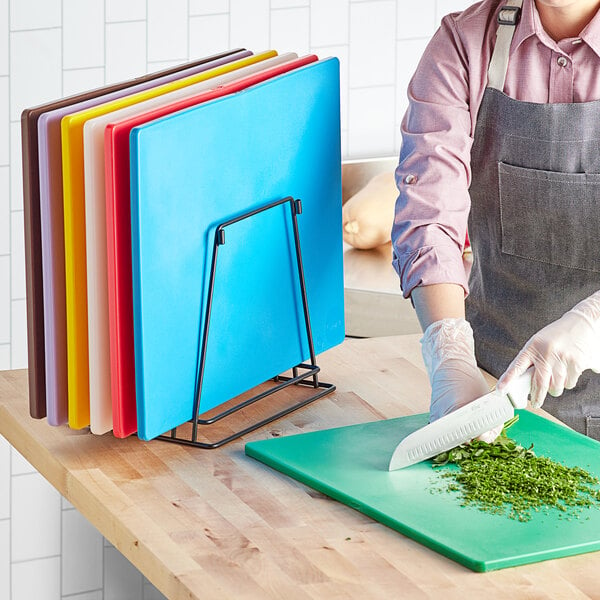
Oil a wood or bamboo cutting board at least once a month, but increase frequency to bi-weekly if it shows signs of drying, such as a pale color or a rough, splintered surface. The best indicator is the board's appearance, as whenever it looks dry and faded, it's time for a new coat of oil to maintain its water-resistant barrier. Plastic cutting boards do not need to be oiled.
What Cutting Board Is the Best for Meat?
In a commercial kitchen, the best cutting board for raw meat is a color-coded, high-density polyethylene (plastic) board, as its non-porous surface can be reliably sanitized in a commercial high-temperature dishwasher after each use.
The FDA allows hard maple or equivalently-hard, close-grained wood for cutting boards, but many kitchens still prefer HDPE because sanitization is easy to repeat, verify, and document. Designating a specific color, like red, exclusively for raw meat is an industry-best practice that provides a crucial visual cue to prevent cross-contamination with ready-to-eat foods.
Why Do Cutting Boards Have Grooves?
Cutting boards have grooves, known as a juice groove or well, to trap liquids from meats, fruits, and other moist ingredients, preventing them from spilling onto the counter and creating a slip hazard or a sanitation issue. This feature is particularly valuable for butchery tasks or when working with large quantities of juicy produce in a high-volume setting.
Which Side of the Cutting Board to Use?
For a board with a juice groove, use the grooved side for cutting juicy ingredients like meats and melons, and the flat side for all other general prep work to ensure stability. If both sides are flat, use only one side for raw proteins and the other for ready-to-eat foods, or ideally, use entirely separate, color-coded boards to eliminate any risk of cross-contact.
How Thick Should a Cutting Board Be?
A commercial cutting board should have at least a thickness of 3/4-inch, with 1 1/4-inch to 1 1/2-inch being the ideal range for durability, stability, and resistance to warping under heavy use. This thickness provides sufficient weight to prevent slipping on the countertop and can withstand repeated deep cleaning and resurfacing without compromising its structural integrity.
Wood Cutting Board Safety FAQ
Wood cutting boards are prized in professional kitchens for their knife-friendly surface and durability, but they require specific care and preparation for proper use. Understanding the properties and maintenance of wood is essential for any operator choosing to use it.
Are Wood Cutting Boards Safe?
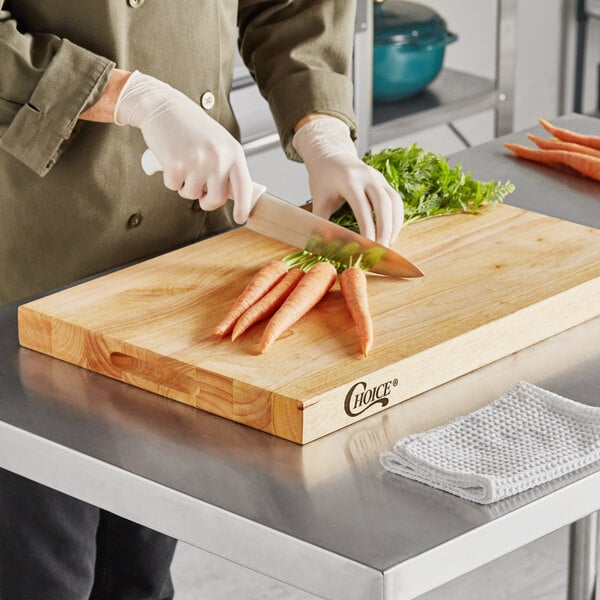
Yes, properly maintained wood cutting boards are perfectly safe for commercial use. Bacteria can wick into the wood matrix and are less recoverable, but results vary by species and condition. Diligent cleaning and thorough drying to prevent bacteria build-up are what make wood safe.
What Is the Best Wood for a Cutting Board?
The best woods for commercial cutting boards are tight-grained hardwoods like maple, walnut, and cherry. Maple is the industry standard for its exceptional hardness and closed-grain structure that resists scoring and moisture penetration. Avoid soft, porous woods like pine, as they scar easily and can harbor bacteria within deep grooves.
Can You Put a Wooden Cutting Board in the Dishwasher?
No, you must never put a wooden cutting board in a commercial dishwasher. The extreme heat and prolonged moisture will cause the wood to warp and crack, destroying its structural integrity and creating fissures where bacteria can thrive, rendering it unsafe for use.
Are Wood Cutting Boards Heat Resistant?
Wood cutting boards offer moderate heat resistance suitable for resting a hot pan or roast briefly, but they are not designed for direct contact with high-heat sources like a pot from the stove. Placing a burning-hot pot directly on wood can scorch the surface, compromise the oil seal, and potentially create a fire hazard. Always use a trivet for items straight from the burner.
Bamboo Cutting Boards Safety FAQ
Bamboo cutting boards have become popular due to their sustainability and hardness, but they require distinct care from traditional wood. Proper maintenance is key to ensuring its longevity and food safety in a commercial environment.
Are Bamboo Cutting Boards Safe?
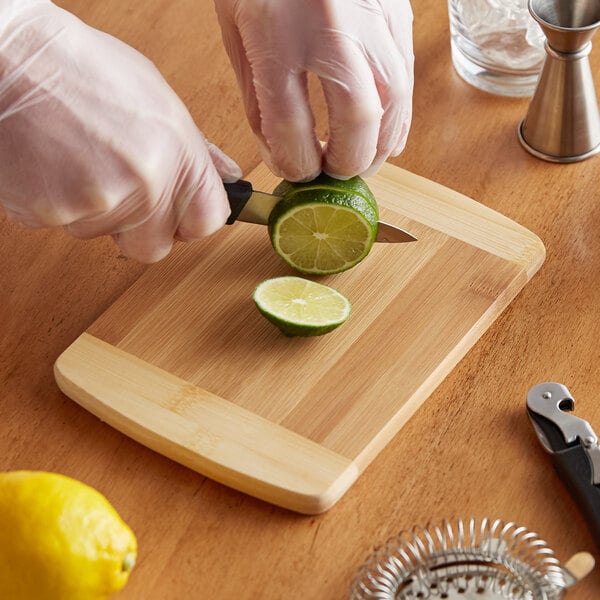
Yes, bamboo cutting boards are a safe and sanitary option when maintained correctly. Bamboo is harder than many woods, making it more resistant to knife scarring where bacteria can hide, and its natural antimicrobial properties provide an added layer of protection against pathogen growth when the board is cleaned and dried promptly after use.
Can You Put Bamboo Cutting Boards in the Dishwasher?
No, placing a bamboo cutting board in a dishwasher will cause irreversible damage. The intense heat and water pressure will cause the laminated strips to delaminate and warp, and the board will likely split along the seams, creating deep cracks that harbor bacteria and render it unusable.
Do You Have to Oil Bamboo Cutting Boards?
Yes, you must oil bamboo cutting boards regularly to prevent drying and cracking, despite bamboo's natural resistance to moisture. Treat a new bamboo board with food-grade mineral oil immediately, and re-oil it every few weeks or whenever the surface begins to look pale or feel rough to the touch.
Plastic Cutting Boards Safety FAQ
Popular in commercial kitchens for their affordability and durability, plastic cutting boards demand rigorous protocols to maintain food safety. Their non-porous surface is easy to sanitize but susceptible to deep grooves that can compromise hygiene over time.
Are Plastic Cutting Boards Safe?
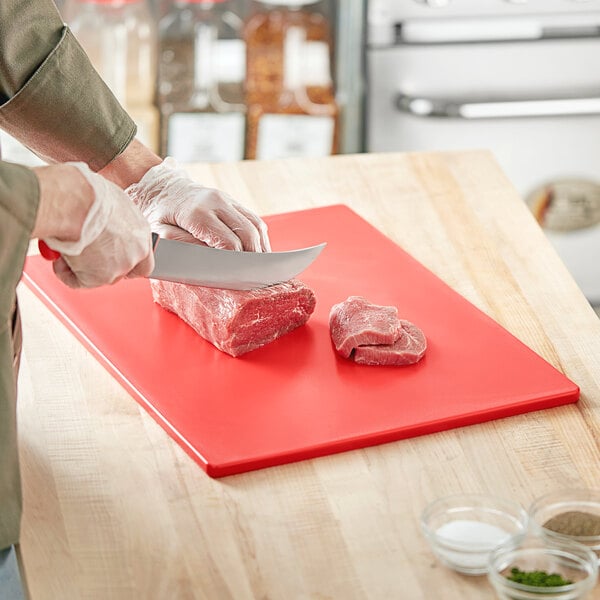
Plastic cutting boards are safe, provided they are part of a strict color-coded system and are professionally sanitized after every use, especially when working with raw proteins. Their safety is contingent on their surface condition; once heavily scarred by knives, they can develop deep, difficult-to-clean grooves that harbor dangerous bacteria like Salmonella and E. coli.
Can You Put Plastic Cutting Boards in the Dishwasher?
Yes, most high-density polyethylene (HDPE) plastic boards are designed to withstand the high-temperature wash and sanitize cycles of a commercial dishwasher, which is the most effective method for eliminating pathogens. Always check the manufacturer’s specifications, as extreme heat can cause some thinner boards to warp, potentially affecting their stability.
How to Remove Stains from a Plastic Cutting Board
To remove stubborn stains and odors from a plastic cutting board, create a paste from baking soda and water or use a commercial-grade cutting board cleaner containing a bleaching agent approved for food contact surfaces. Scrub the paste vigorously into the stained area, let it sit for several minutes, then rinse thoroughly and run the board through the dishwasher to complete the sanitization process.
When to Replace a Plastic Cutting Board
Replace a plastic cutting board when the surface becomes deeply and extensively scarred, a point you can easily check by dragging your fingernail across the grooves. If your fingernail catches, the grooves are too deep to clean effectively. Other signs for immediate replacement include permanent, deep staining that won’t wash out and any warping that causes the board to rock unstably on a countertop.
Ultimately, cutting board safety is a matter of implementing rigorous, material-specific maintenance and replacement protocols. Your commitment to these practices upholds HACCP principles and protects public health, creating a safer and more sanitary environment for all.



